| Article ID | Journal | Published Year | Pages | File Type |
|---|---|---|---|---|
| 526820 | Image and Vision Computing | 2015 | 19 Pages |
•A two-phase strategy for combining separate cost volumes is described.•A mean-shift segmentation-driven approach to handle disparity outliers is utilized.•Low-textured area plane fitting is fostered by using disparity histogram analysis.•Our method ranks first among published methods in the Middlebury evaluation system.
This paper presents a novel stereo disparity estimation method, which combines three different cost metrics, defined using RGB information, the CENSUS transform, as well as Scale-Invariant Feature Transform coefficients. The selected cost metrics are aggregated based on an adaptive weight approach, in order to calculate their corresponding cost volumes. The resulting cost volumes are then merged into a combined one, following a novel two-phase strategy, which is further refined by exploiting scanline optimization. A mean-shift segmentation-driven approach is exploited to deal with outliers in the disparity maps. Additionally, low-textured areas are handled using disparity histogram analysis, which allows for reliable disparity plane fitting on these areas. Finally, an efficient two-step approach is introduced to refine disparity discontinuities. Experiments performed on the four images of the Middlebury benchmark demonstrate the accuracy of this methodology, which currently ranks first among published methods. Moreover, this algorithm is tested on 27 additional Middlebury stereo pairs for evaluating thoroughly its performance. The extended comparison verifies the efficiency of this work.
